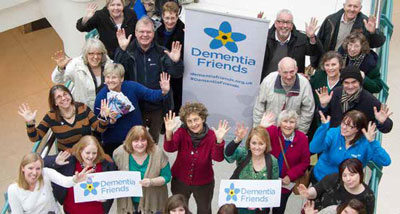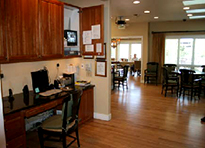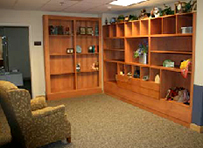People with dementia rely on environmental cues to support them physically, cognitively, and emotionally. Unfamiliar, chaotic, or disorganized environments—whether at home, in adult daycare, or in a care facility—are stressful and can cause anxiety, disorientation, and contribute to behavioral problems.
A therapeutic environment provides support for someone with dementia and their family. It recognizes that people with dementia are influenced by their surroundings and do better with environments that are individualized, flexible, and designed to support differing functional levels and approaches to care (Campernel & Brummett, 2010). At a minimum, an organization caring for people with dementia should understand that people with dementia deserve and need kind and supportive care focused on dignity, respect, and autonomy.
Philosophy of Care
Environment is dictated by an organization’s philosophy of care—a framework that identifies care goals and values. A healthcare organization’s philosophy of care may differ from that of the family. Family members have the right to know and should feel free to question a center’s philosophy of care:
- Is the center’s philosophy for caring consistent with your beliefs?
- Does the center provide services to persons at all stages of dementia?
- What conditions or behaviors determine whether a center will admit or retain someone with dementia?
- Is dementia care provided in a separate unit or as an integrated part of center’s services?
- Is the center’s philosophy and practice of handling “difficult behaviors” compatible with your views?
- What is the center’s philosophy in using physical restraints to deal with certain behaviors?
- Does the center recommend the use of psychoactive drugs to treat behaviors? (California Advocates for Nursing Home Reform, 2020)
Dementia Friendly Care
Dementia Friends

Courtesy Alzheimer’s Disease International.
In long-term care dementia friendly is a commonly used term. It focuses on the experience of people with dementia and advocates for positive attitudes and behaviors toward dementia. It seeks to treat people with dementia and their caregivers with dignity and respect and calls for an end to stigma. It seeks community support for people affected by dementia so they can “live well with dementia” (ADI, 2015).
The Japanese Dementia Friends model is an example of a program that provides services throughout the country. Japan’s nationwide campaign, a 10-Year Plan to Understand Dementia and Build Community Networks, has provided training for 1 million “cognitive disorder” supporters. The program has been copied in the United Kingdom.
Person-Centered Care
Person-centered care, also called dementia-friendly care, depends on a caregiver’s and organization’s skills, training, and knowledge. It means that care is built around the needs and preferences of the client, the care professional, and the caregiver. The goal is to create a high-quality, joyful, shared environment.
Person-centered care is flexible, creative, and supportive. Person-centered care promotes inclusion of the person living with dementia and their caregivers in care and treatment decisions, with the aim of increasing positive outcomes for both (Handley et al., 2015).
Person-centered care is the opposite of task-centered care. In dementia care, it involves practices aimed at helping your client establish relationships and be treated as an individual with their own life history and interests (Desrosiers et al., 2014).
An innovative person-centered approach called “green care farms” has been developed in the Netherlands, which provides daycare services and 24-hour nursing home care to people with dementia. Green care farms offer a broad selection of activities, including caring for plants and animals, and encourage clients to engage in tasks suited to their level of dementia and physical capabilities (de Boer et al., 2015).
Some green care farms provide day-care services. In a study on daycare services at green care farms it was suggested people deliberately chose green care farms because of their dislike of the institutional environment of regular daycare facilities. Green care farms were perceived as more useful for clients, more meaningful, and providing more opportunities to be physically active and to go outdoors (de Boer et al., 2019).
The Physical Environment
There is a profound and direct connection between the environment and the way people feel and behave. Buildings thoughtfully designed for the care of people with dementia encourage community, maximize safety, support caregivers, cue specific behaviors and abilities, and redirect unwanted behaviors (Campernel & Brummett, 2010). This approach to dementia care considers the consequences of the built environment on the well-being of clients with dementia (Rijnaard et al. 2016).
For long-term care facilities, there is a trend toward designing facilities to be as homelike as possible. This idea was pioneered in Sweden in the 1980s, where a homelike environment for people with dementia was tried for the first time. Today, similar concepts can be found all over the world, from Green Houses in the United States, to group homes in Japan, small-scale living arrangements in the Netherlands, and German shared-housing arrangements (Gräske et al., 2015).
These concepts challenge the traditional view, in which care is organized around nursing and medical tasks and the needs of the institution. Living arrangements in small and homelike settings are built around person-centered care, respecting residents’ needs and choices. Daily routines include meaningful activities to encourage normal living while tasks focus on household chores such as cooking and baking (Gräske et al., 2015).
Specific design principles have been shown to reduce unwanted behaviors and enhance a sense of well-being in people with dementia. These include:
- Providing private spaces and a separate room or recess for sleeping or napping
- Providing easily accessed public spaces and places for semi-private interactions
- Keeping public spaces clean and getting rid of odors
- Providing sunlight, ventilation, and getting rid of dark nooks and crannies
- Providing views to the outside.
- Replacing institutional, centralized nursing stations with smaller, residential-looking stations
- Creating spaces to cue specific behaviors (activity kitchen, art and music therapy area, bistro/bar, rummaging room, library, coffee shop/internet café, quiet room, living room)
Living Spaces Designed for Dementia Patients


Left: Residential-looking, smaller-scaled nurses’ station. Right: a room for rummaging. Source: Campernel & Brummett, 2010. Used with permission.
Outdoor design ideas for people with dementia and memory disorders include:
- Arranging outdoor spaces to resemble a natural community
- Creating continuous circulation routes with looping pathways and areas of interest
- Including clients in the design of new features such as walking paths and gardens
- Creating safe, purposeful, heated, and accessible outdoor areas
- Offering attractive landscaping, gardens, and pleasing views (Rijnaard et al. 2016)


Left: Safe, looping wandering paths with areas of interest along the way. Right: A memory-care facility with home-like outdoor porch area for seating and reflection. Source: Campernel & Brummett, 2010. Used with permission.
In a comparison of “regular” specialized care units and small, homelike specialized care units in the Netherlands, clients in the homelike care units needed less support with activities of daily life, were more socially engaged, showed less agitation over time, and needed less psychotropic medication and physical restraints. Residents of the small, homelike units awarded higher scores to aspects of quality of life, showed less negative affect and better social relationships, and were more engaged in activities (Kok et al., 2016).
Safety and Security
People with dementia need to feel safe (and be safe) without the use of physical and chemical restraints. Safety includes creating an appropriate environment as well as planning for adverse events, such as wandering away from the home or facility.
The table below illustrates some common safety hazards and measures to help make the environment more safe and secure. Since every situation is different, interventions must be tailored to match the specific circumstances.
Measures to Promote Safety and Security | ||
|---|---|---|
Safety issue | Possible consequence | Intervention |
Wandering | Getting lost, exposure to environmental hazards |
|
Cooking without supervision | Fire, injury |
|
Falls | Injury |
|
Poisoning | Sickness or death |
|
Simply receiving care at an adult daycare center can be a source of safety and security for a person with dementia. Having regular contact with a caregiver provides a sense of privacy, safety, and security. A well-designed and well-run facility is secure, comfortable, and predictable; it is a place where one can feel at ease—a place where you can be who you are and feel connected with like-minded people (Rijnaard et al., 2016).
Adult daycare services can also offer a sense of safety and security for caregivers, providing a feeling of shared responsibility and respite (Tretteteig et al., 2017).
Schedules and Routines
Schedules and routines are an important part of any person’s life and well-being. However, when someone enters a facility or participates in a daycare program, their usual routines are interrupted and altered. This creates a tension between the necessary institutional routines and the clients’ personal habits and needs (Rijnaard et al., 2016).
In traditional elder care facilities, schedules and routines are primarily organized around the convenience of the staff. As a result, schedules can change dramatically from day to day. This is difficult for people with dementia because they rely on a predictable routine for orientation. A regular routine allows a person with dementia to know what to expect. Routines also give the caregivers a benchmark for evaluating a person’s behavior. A schedule for someone with dementia should:
- Be planned carefully.
- Consider each person’s capabilities and preferences.
- Continue familiar routines and schedules.
- Maintain mealtime routines.
- Maintain regular dental and healthcare appointments.
- Allow plenty of time.
- Note the effects of changes in routines.
- Consider issues that disrupt routines (ie, pain, fatigue, illness).
Caregivers responsible for maintaining a routine schedule must be flexible. People with dementia tend to be slow, so caregivers must allow ample time for meals and activities. Attempting to rush can precipitate aggressive behaviors and frustrate both parties.
Staff as Part of the Environment
In Florida, adult daycare centers must employ qualified staff to provide the services, personal assistance, and safety measures required by participants. Nearly 60% of workers in adult daycare centers are aides, 18% are registered nurses, 11% are licensed practice nurses, and about 12% are social workers (Harris-Kojetin et al., 2016).
If centers provide adult day health care, the following staff members are required:
- A registered nurse or licensed practical nurse on site during the primary hours of program operation and on call during all hours the center is open; all LPNs must be supervised by an RN;
- A social worker or case manager to provide and supervise the provision of social services, including counseling for participants’ families and caregivers and compilation of a social history and psychosocial assessment of formal and informal support systems, and mental and emotional status; and
- An activity director or recreation therapist, who may be retained as a consultant. All services provided by program aides must be directly supervised by the activity director or recreation therapist (O’Keefe, 2014).
Proper Staffing
The importance of having sufficient, competent staff to ensure quality of care is a major concern in many countries. High turnover and difficulties recruiting qualified staff are common challenges. Several significant factors that may impact job satisfaction and the ability to provide quality care have been identified. These include unclear roles and functions, heavy workloads, demanding work schedules, difficult ethical issues, and job strain, such as stress of conscience and burnout (Vassbø et al., 2019).
Dissatisfaction with work can result in lower loyalty to the workplace and an increased probability of leaving the workplace. Research indicates that those who are dissatisfied with their working conditions have an increased tendency to avoid work responsibilities through absence, purposely avoiding activities, taking shortcuts, or making themselves unavailable when actions are required. Therefore, there is a great need to identify ways to improve job satisfaction (Vassbø et al., 2019).
A person-centered approach has been shown to decrease staff turnover, improved worker satisfaction, and reduce participants’ unwanted behaviors. This is accomplished by (1) meeting an individual’s needs and preferences in close relationships, (2) establishing shared goals, (3) understanding clients’ rhythms and preferences, (4) doing the “little extra” for clients, (5) being a part of a supportive team, and (6) sharing professional values (Vassbø et al., 2019).
In adult daycare centers in Florida, staffing must be maintained to meet participants’ needs, including centers that serve persons with Alzheimer’s disease and other types of dementia (O’Keefe, 2014):
- All adult day centers: at a minimum, 1 staff member providing direct services for every 6 participants.
- Specialized Alzheimer’s adult day center: at a minimum, 1 staff member providing direct services for every 5 participants with Alzheimer’s disease or other dementia.
- All adult day centers: at a minimum, 2 staff (1 of whom has a certification in first-aid and CPR) must be present in the center at all times. (O’Keefe, 2014)
The owner or operator may be counted as one of the required staff members if that person provides direct services and is included in the center’s work schedule. However, the owner or operator must not be counted more than once in the staff-to-participant ratio, calculated on the basis of daily census (O’Keefe, 2014).
Staff Adjusting to Resident Routines
In adult daycare settings, as in other elder-care settings, activities are usually centered on tasks and activities. Ideally, clients are cared for by a small, fixed team of trained caregivers and activities are organized completely, or in large part, by clients and caregivers. Staff members, clients, and family members can prepare meals together, assist with personal care, and participate in activities.
To encourage integration of the staff into a home-like environment, the following practices are recommended:
- Hire staff with the emotional skills to interact with people who have memory problems.
- Eliminate institutional, centralized nursing stations.
- Locate nursing and work areas throughout the building for staff convenience.
- Allow staff to control lighting and environmental levels.
- Emphasize signage for clients.
- Limit signage for staff and visitors.
- De-emphasize or camouflage doors to staff and utility areas.
- Keep staff consistent.
